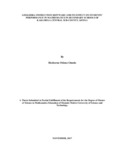| dc.contributor.author | Omolo, Hesborne Otieno | |
| dc.contributor.author | EDM/G/05/08 | |
| dc.date.accessioned | 2017-11-24T13:12:18Z | |
| dc.date.available | 2017-11-24T13:12:18Z | |
| dc.date.issued | 2017-11 | |
| dc.identifier.uri | http://r-library.mmust.ac.ke/123456789/271 | |
| dc.description.abstract | Mathematical knowledge and understanding is important not only for scientific progress and
development but also for its day-to-day application in social sciences and arts, government,
business and management studies as well as household chores. But the general performance in
school mathematics in Kenya has been poor over the years. There is evidence that students
have problems in understanding and interrelating the symbols and special language structure
as used in mathematics. Broad curricula, lack of facilities and inadequate staffing were always
cited as the major causes of the problem. Although dismal performance in the subject had
almost been accepted as the norm in some schools, the Ministry of Science, Education and
technology (MoEST) and other stakeholders felt there had to be an intervention. The study
sought to explore the effectiveness of using Geogebra Instruction Software as a pedagogical
tool in secondary school mathematics, as contrasted to conventional teaching methods on
student’s performance in mathematics scores and their creativity. The study was carried out in
a real classroom setting that involved comparisons between the treatment and control groups.
A Quasi-experimental nonequivalent Solomon- Four fold research design employed involved
eight secondary schools in Kakamega Central Sub-County. A total of 20 teachers of
mathematics and 240 form two students’, randomly sampled (using proportionate stratified
random sampling) were enrolled in four intact classes from the selected schools and exposed
to the similar contents on the topic of transformations for a period of two weeks. Both
descriptive and inferential statistics were used to analyse the data. Descriptive statistics
involved the use of means and standard deviations while inferential statistics involved an
analysis of variance (ANOVA). The findings of the study showed that the computer
instructional software Geogebra as an instruction medium was superior to the conventional
methods as regards the students’ creativity, attitude and achievements in mathematics at
secondary school level. Based on these findings, the researcher recommends that; for quality
and optimum learning to occur in present times, an effective instructional approach that the
21st century mathematics teacher should embrace is computer based instructional software.
This method not only enhances mastery of content but also improves on learners’ retention
rate and increases their involvement in | en_US |
| dc.description.sponsorship | School of Education | en_US |
| dc.publisher | MMUST | en_US |
| dc.subject | Analysis of Variance | en_US |
| dc.subject | Computer Aided Instruction | en_US |
| dc.subject | Dynamic Geometry Software | en_US |
| dc.subject | Conventional Methods of Instruction | en_US |
| dc.subject | In-Service Training | en_US |
| dc.subject | Dynamic Mathematics Software | en_US |
| dc.subject | Mathematics Classroom Environment Questionnaire | en_US |
| dc.title | GEOGEBRA INSTRUCTION SOFTWARE AND ITS EFFECT ON STUDENTS’ PERFORMANCE IN MATHEMATICS IN SECONDARY SCHOOLS OF KAKAMEGA CENTRAL SUB-COUNTY, KENYA | en_US |

